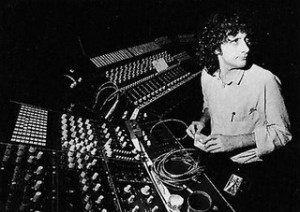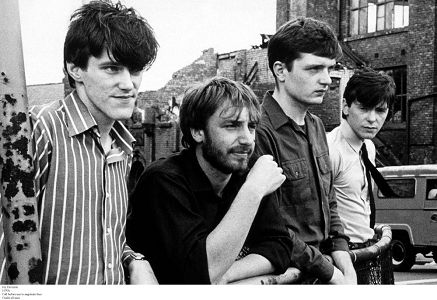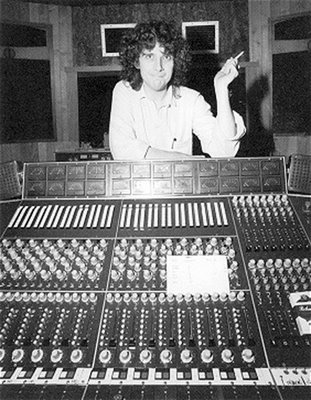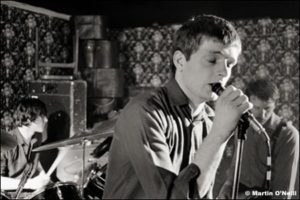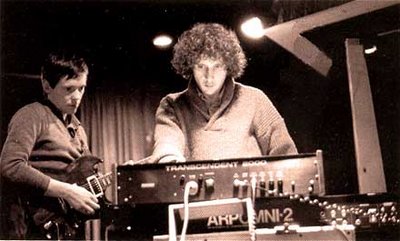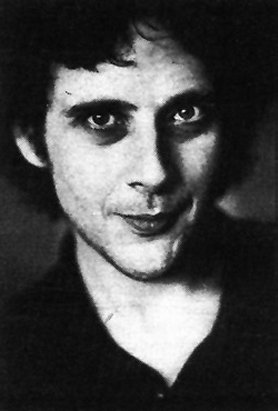“The Mad Genius of Manchester”: A Profile of Producer Martin Hannett
This story first appeared in Trust Me, I’m a Scientist, August 1, 2011.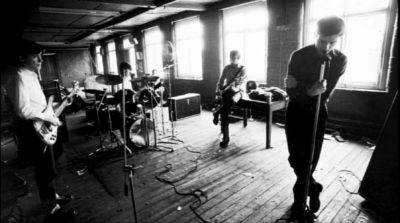
Joy Division was something of an anomaly.
Existing for fewer than four years and releasing only two albums in 1979 and 1980, the band continues to remain intriguing, relevant, and influential to new generations of musicians and fans.
The tragic suicide of singer Ian Curtis and the remaining members’ unlikely rise from the ashes as New Order may act as perpetual fodder to initiating new interest. But the band’s music endures on the power of their lightning-fast evolution from punk retreads to harbingers of a musical future. It was a process that was neither accidental, nor wholly a function of their own will.
One could say that there were two Joy Divisions. Live, Joy Division was a force of nature, a hurricane of unpolished sound and fury born out of naïve punk angst, the bleak backdrop of Manchester, and the constant tensions brought on by Curtis’ personal demons and physical illness. By contrast, the recorded Joy Division was cold and reserved, full of cavernous and uncharted spaces—each song a crystalline museum piece encased in glass.
The first Joy Division was the essence of young men who felt the world’s weight on their shoulders. The sound of the second Joy Division (and what would become their legacy) was the work of the Mad Genius of Manchester, Factory Records producer Martin Hannett.
MARTIN “ZERO”
“Again, I was trying to do things, and the engineer was turning them off when I looked round. ‘You don’t put that kind of echo on a snare drum!’”
– Martin Hannett
Like all the key players in the Factory Records story, Hannett was a study in dualities. Depending on you asked, he was either a self-important and insufferably mean drug addict, or a forward-thinking technician and true visionary.
A failed chemistry student, Hannett broke into the Manchester music scene from many angles (as a bass player in local act Sad Café, a live sound engineer at pubs, and briefly, as the founder of a musician’s co-operative) before establishing a reputation for his production work on of The Buzzcocks’ Spiral Scratch EP.
Although Spiral Scratch introduced the world to Martin Zero (his early production moniker), in a rare interview with Jon Savage, Hannett explained that the recording was far from what would become his trademark production aesthetic.
“Again, I was trying to do things, and the engineer was turning them off when I looked round. ‘You don’t put that kind of echo on a snare drum!’… It was never finished. I would have loved to have whipped it away and remixed it, but he erased the master because he thought it such rubbish. I’d get that everywhere I went.”
 Hannett’s work with the Buzzcocks led to an early partnership with Rabid Records, where he produced acts like Slaughter and the Dogs, Jilted John, and John Cooper Clark. The latter collaboration saw Hannett couple Cooper Clark’s snarling punk poetry with his own synths, drum machines, and bass playing- just one aspect of Hannett’s full bore ‘hands on’ approach. He would soon meet and work with Joy Division; a marriage of raw sound and futuristic polish that would define the careers of both band and producer.
Hannett’s work with the Buzzcocks led to an early partnership with Rabid Records, where he produced acts like Slaughter and the Dogs, Jilted John, and John Cooper Clark. The latter collaboration saw Hannett couple Cooper Clark’s snarling punk poetry with his own synths, drum machines, and bass playing- just one aspect of Hannett’s full bore ‘hands on’ approach. He would soon meet and work with Joy Division; a marriage of raw sound and futuristic polish that would define the careers of both band and producer.
UNKNOWN PLEASURES AND CLOSER
“Martin didn’t give a fuck about making a pop record. All he wanted to do was experiment. His attitude was that you get a load of drugs, lock the door of the studio and you stay in there all night and you see what you’ve got the next morning. And you keep doing that until it’s done.”
– Bernard Sumner, Joy Division/ New Order
Hannett was first introduced to Joy Division by the band’s one-time drummer and manager Terry Mason, who came to Hannett’s musician’s co-op looking to rent a PA system. During a rough performance at Salford Tech, Hannett immediately saw the recording potential of the band.
“They were really good. The PA broke down, and Steve (Morris) and Hooky (Peter Hook) busked for about fifteen minutes. One of the things that drove me to drum machines was the appalling quality of drummers, and Steve was good, so immediately they had a red hot start. They were different from punk. It might have put me off if I’d seen them in that Warsaw, Leaders of Men period. There was lots of space in their sound initially, before Bernard started falling asleep over polyphonic synthesizers, there used to be a lot of room in the music.”
By mid-1978, Joy Division were establishing themselves as new Mancunian heavyweights while quickly outgrowing their archaic punk roots. Immediately after self-releasing their debut An Ideal For Living EP, the band embarked on a brief and disastrous relationship with RCA records in which they were recruited to cover N.F. Porter’s soul hit “Keep On Keepin’ On” in exchange for personal studio time.
The band tried – and failed – to produce the cover (their mangled interpretation eventually formed the basis of the song “Interzone”), but penned and recorded many of the songs that would come to make up the bulk of Unknown Pleasures.
After the sessions were completed, a short legal battle ensued, with the band ultimately being freed from their obligations just in time to sign with former television host Tony Wilson’s new Factory Records.
In advance of the band’s signing, Wilson had also lured Hannett away from Rabid Records to act as Factory’s in-house producer. Hannett, along with Wilson, mutual friend Alan Erasmus, and Joy Division manager Rob Gretton, formed the core partnership of Factory Records. Their first LP would be Joy Division’s Unknown Pleasures.
It was from these early sessions with Joy Division that Hannett’s multi-faceted reputation as both genius and madman began to grow into legend. Almost a decade older than the band, Hannett assumed the role of master and commander in the studio, pushing his own ideas forward at every turn while decrying those of others.
Joy Division bassist Peter Hook recalls: “Bernard and I were very down to earth and he was, like, from another planet. He was just this really weird hippy who never talked any sense at all. At least, I never knew what he was talking about anyway. Still, you had a rapport with him. He used to say to Rob, ‘Get these two thick stupid cunts out of my way’. In the studio, we’d sit on the left, he’d sit on the right and if we said anything like, ‘I think the guitars are a bit quiet, Martin,’ he’d scream, ‘Oh my God! Why don’t you just fuck off, you stupid retards.’ It was alright at first, but gradually he started to get weirder and weirder.”
To equal the might of his dictatorial control, Hannett added experimentation in spades. The bourgeoning revolution in digital effects of the late 70s allowed Hannett to finally bring the sounds in his mind to tape, and Joy Division served as the perfect vessel for them.
“The gig at Salford was very important. It was a very big room, and they were very badly equipped, and they were still working into this space, and making sure they got into the corners. When I did the arrangements for recording, they were just reinforcing the basic ideas.”
Hannett reinforced Joy Division’s ideas by employing his arsenal of digital choruses, reverbs, and delays- among them a Melos tape delay and three AMS digital delay units (now used heavily by Radiohead’s Johnny Greenwood). Joy Division’s first recording for Factory, song released as part of an early Factory sampler EP, was titled “Digital” in honor of the delay line Hannett had acquired just weeks prior.
Hannett’s work with Joy Division on Unknown Pleasures found him completely untethered from rules, convention, or expectation for the first time. Wilson, wanting an eccentric genius behind the console had given Hannett carte blanche. The band, for their part were- as Hannett put it- “a gift to a producer, cos they didn’t have a clue. They didn’t argue.”
Hannett added haunting, non-musical samples to the recording, including breaking glass and an elevator lift. He made use of extreme panning and added massive reverb to the guitars, often using doubling or even tripling effects for a sound that was at once monolithic and reserved.
Drums (his obsession) were also given fair amounts of reverb and a small amount of digital delay to emphasize snare hits. Factory label mate Vini Reilly of the Durutti Column recalls the familiar sound: “Martin used that digital delay not as a repeat echo delay but to make a tiny millisecond that came so close to the drum it was impossible to hear. I would never thought of doing that. Nobody else would. I don’t know how he could have possibly envisaged the final sound.”
In addition to the effects, the sounds captured in the drum room were sent to a solitary Auratone speaker perched on top of a toilet in the basement of Strawberry Studios, which was recorded back through a single microphone and further effected. This would become a trademark Martin Hannett drum treatment.
In a delicious bit of irony, Hannett worked with Sumner to employ various synthesizers such as Transcendant 2000s and ARP Omnis, a process that the band had argued against during their RCA debacle just a half a year earlier. They had told the producer it would synths would corrupt and cheapen their music.
The flipside to Hannett’s forward-thinking was on display in the form of his drug-induced nastiness and paranoia.
On the third day of recording, Hannett infamously ordered Stephen Morris to disassemble his entire drum kit piece by piece (an incident now immortalized in the Factory-centric film 24 Hour Party People) in order to locate a small rattle he swore was bleeding through. He blasted the air-conditioning at inopportune times and at inhuman temperatures. In addition to ignoring the band’s verbal suggestions, Hannett went to great lengths to avoid them altogether, choosing to complete his final mixes at odd early morning hours so that they would have difficulty attending the sessions.
“Martin didn’t give a fuck about making a pop record. All he wanted to do was experiment. His attitude was that you get a load of drugs, lock the door of the studio and you stay in there all night and you see what you’ve got the next morning. And you keep doing that until it’s done. That’s how all our records were made. We were on speed, Martin was into smack,” says Bernard Sumner.
Unknown Pleasures arrived in late 1979 to rave reviews. Factory was the label of the future, Joy Division was the band to take them there, and Hannett would be the one to put it all to tape. He had used a host of unproven gadgets, dub recording techniques, and flights of fancy from the furthest recesses of his mind to tame the savage beast that was live Joy Division. Fittingly, Hook and Sumner carry mixed emotions about the record into the present.
In the liner notes to the 1997 box set Heart and Soul, Bernard Sumner recalls: “We played the album live. The music was [originally] loud and heavy, and we felt that Martin had toned it down, especially with the guitars. The production inflicted this dark, doomy mood over the album: we’d drawn this picture in black and white, and Martin had colored it in for us… We resented it, but Rob loved it, Wilson loved it, and the press loved it, and the public loved it: we were just the poor stupid musicians who wrote it! We swallowed our pride and went with it.”
In March of 1980, Joy Division would record their second and final album Closer at Britannia Row studios in London, again with Hannett at the controls.
Ian Curtis’ worsening epilepsy and recurring fits, deteriorating marriage, and affair with Belgian journalist Annik Honore (who stayed with him in London during the recording) contributed to cast a strange atmosphere over the recording.
Hannett referred to it as the “most mysterious” record he had ever recorded: “That album was made as closed as possible, kabalistic, locked in its own mysterious world…”
He continued to experiment, although now (sometimes) listening to the band, using more live echo effects by incorporating playback speakers throughout the studio. In perhaps his most unorthodox move, Hannett convinced Stephen Morris to record each drum part of a song separately, hitting the necessary drum on the necessary beat while “ghosting” the other hits on his knees and thighs (which were red and raw by the end of the sessions). This allowed Hannett to isolate and effect each drum sound individually, a technique that probably would have failed miserably if not for Morris’ considerable technical skill and time-keeping, and one that remains largely un-copied today.
Closer was released in July of 1980, two months after Curtis committed suicide. The tragedy surrounding its release only increased the mythology surrounding Joy Division’s now completed career arc, and the eerie final recordings with Hannett.
Although Closer could have been the height of Hannett’s early professional career and a sign of things to come, the blow of Curtis’s suicide surely contributed to Hannett’s own downward spiral. Hannett remembered his friend with a unique admiration: “He was one of those channels for the Gestalt. A lightning conductor. He was the only one I bumped into, in that period.” Hannett himself would be dead just over a decade later at the age of 42.
THE POST-PUNK PHIL SPECTOR
“‘E’s a fookin’ mate to the Mondays, Martin. He’s great when ‘e’s with us, man. Mind, ‘e likes workin’ with us ‘cos we give ‘im a lot of E durin’ the sessions, right!
– Shaun Ryder, Happy Mondays
Based on the strength of his work with Joy Division, Hannett received several offers to work for bigger record companies.
A combination of civic loyalty, a general distaste for the music business at-large, and his continued stake in Factory Records kept him in Manchester, though, and he continued his work with their stable of young, malleable, and un-argumentative artists.
By his own admission, Hannett was also a bit of a reclusive drug addict, who preferred to be left alone shooting heroin when not working (and sometimes while). Manchester and his role at Factory suited his personal and professional agenda just fine. Meanwhile the “Hannett sound” became a known quantity in recording parlance (a 1981 Dead Kennedys recording of “Nazi Punks Fuck Off” begins jokingly with the line “overproduced by Martin Hannett”).
From the late 70s until the mid-80s, Hannett worked with a variety of artists, both in and outside of Factory. He recorded early singles by the likes of OMD, The Stone Roses, and even U2 before they moved on to majors.
New Order recorded their first album and singles with Hannett before amicably parting ways in 1981 (the band would credit Hannett with giving them the background to self-produce their later material), as did Howard Devoto’s post- Buzzcocks band Magazine, whose album The Correct Use of Soap Hannett considered his best production.
Hannett even played a small, unwitting role in the rise of hip hop. The song “UFO”- which he recorded with ESGm the pared down, spaced-out teenage funk outfit from the Bronx, would be sampled countless times in the coming decades.
Of course, with each project came more tales of Hannett debauchery and eccentricity. He would regularly lay under the mixing desk during recording sessions for long periods of silence, causing both the band and his engineer to wonder if he had fallen asleep.
Famously, he once told A Certain Ratio guitarist Martin Moscrop about a take: “Right, I want you to play that again…only this time make it faster, but slower.” (This line would be featured in 24 Hour Party People, only attributed to a session with Joy Division)
Perhaps not surprisingly, hedonistic Happy Mondays frontman Shaun Ryder remembers Hannett fondly:
“’E’s a fookin’ mate to the Mondays, Martin. He’s great when ‘e’s with us, man. Mind, ‘e likes workin’ with us ‘cos we give ‘im a lot of E durin’ the sessions, right! E sorts ‘im right out! During the Hallelujah sessions we were givin’ him two a day and this were when they were twenty-five quid a go, right. But it were worth it ‘cos he kept saying, “I can’t feel anything but I’m in a fookin’ great frame of mind.” Plus it stops ‘im gettin’ too bladdered.’”
In 1982, a dispute over royalties led Hannett to sue Factory and part ways with the label. Never one to mince words, Hannett lambasted Factory, label-head Tony Wilson, and all others involved for what he felt were poor business practices, and a shift away the development of music towards fashionable, high-cost failures like the Factory-owned Hacienda nightclub.
“I’m not allowed to go into the Hacienda. Because it upsets me so much that I become violent and deranged. At the time, I wanted to spend a little money on R&D, for the purposes of making more records. I didn’t want it to become a vehicle for one bunch of fucking megastars, and a few people who manage to crawl up Tony’s arse at the bar in his club.”
In the typical absurdist fashion customary to Factory, Hannett’s lawsuit was given its own catalogue number, was later settled out of court, and Hannett eventually reunited with the label. His most notable work from this period was with the heirs to the Manchester throne left vacant by Joy Division, The Happy Mondays, on their 1988 release Bummed.
By this time, however, Hannett’s penchant for drink and drugs had taken a steep toll; he had ballooned to twice his normal size (over 350 pounds) and become nearly impossible to work with. He recorded sparsely over the last few years of his life before finally succumbing to heart failure in 1991.
NEW DAWN FADES
In August of 1991, Factory Records held their Cities in the Park Festival in remembrance of Martin Hannett.
That year, Factory also released Martin: The Work of Record Producer Martin Hannett, a compilation of his more memorable recordings. Factory would eventually crumble under the weight of its form-over-function attitude and poor business decisions, fading into myth and legend like the old gods of the Golden Age of Manchester who died before it- Curtis, Gretton, Hannett. (Tony Wilson would pass from cancer in 2007).
The story of Factory Records, Joy Division, and Martin Hannett is one of dizzying highs and spectacular lows. Of men who changed the world while acknowledging they could never really leave home. Of humble beginnings, sublime peaks, and a return to dust in the end. Martin Hannett understood this as well as anyone, taking his work extremely seriously, but himself, never too much. For every legend of Hannett listening to a single drum sound for hours on end just to get the right tone, there is another that talks of him falling asleep over the mixing desk during a session to equal it out.
In a rare television segment, Tony Wilson interviewed Hannett at Strawberry Studios. The footage shows them lightly detailing the recording and mixing process before Wilsons asks Hannett point blank whether his work was “an art form” or if he was “just a technician”. On tape, Hannett laughs in a way that suggests the question is absurd, before finally answering: “Of course it’s an art form.”
He ponders this some more and then adds “but it’s also something else. It’s a living.”
Blake Madden is a musicianand author who lives in Seattle.

SUGGESTED LISTENING
The Buzzcoks – “Boredom”
OMD – “Electricity”
The Durutti Column – “Conduct”
A Certain Ratio – “Do the Du”
Joy Division – “Shadowplay”, “Transmission”, “Isolation”, “Heart and Soul”
The Names – “Night Shift”, “I Wish I Could Speak Your Language (Pre-Mix)”
New Order – “Everything’s Gone Green”, “Ceremony”
ESG – “Moody (Spaced out)”, “UFO”
Magazine – “I’m a Party”
Happy Mondays – “Wrote For Luck”
REFERENCES
Jonsavage.com – Jon Savage interview with Martin Hannett
“Unknown Pleasures” – by Chris Ott – 33 1/3 Books
martinhannett.co.uk -The Martin Hannett Biography Project
Allmusic.com – Martin Hannett Biography
VIDEO
Martin Hannett and Tony Wilson at Strawberry Studios in July 1980 http://www.youtube.com/watch?v=XI-w7LjSNi4
Please note: When you buy products through links on this page, we may earn an affiliate commission.







